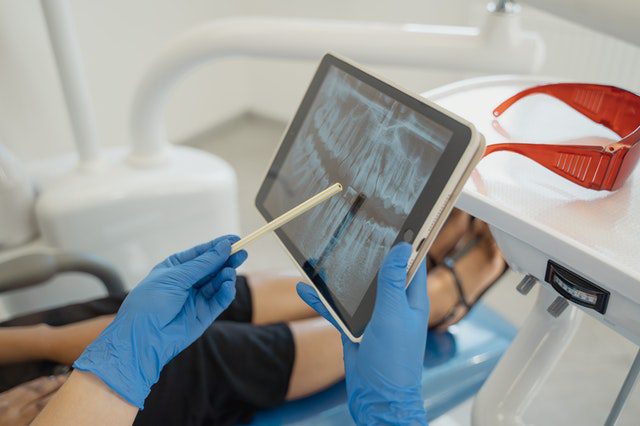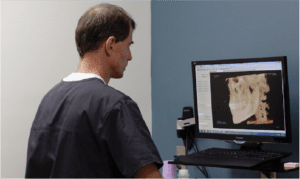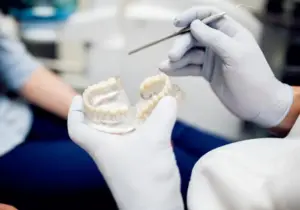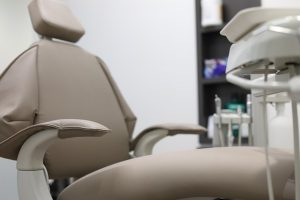We all know the Golden Rule of Wisdom Teeth: get them taken out before they have the chance to cause problems. But what is it about wisdom teeth that makes them problematic? Why are these teeth different? And what’s the urgency on getting an oral surgery to remove your wisdom teeth before you’re even fully done growing?
Wisdom teeth are also referred to as your 3rd molars, because they sit behind your first 2 sets of molars (the ones we actually need). The body and root of a wisdom tooth is much the same as the rest of your teeth; what makes them different is placement, room, and age of development.
Wisdom Teeth: Crowns vs Roots
The crown is the portion of the tooth that sits above the gum line. In wisdom teeth, we usually see just a bit of it start to erupt, which is how your oral surgeon knows it’s time to take your wisdom teeth out. The tooth’s crown is comprised of:
- Enamel: The protective outer layer of your tooth. The enamel prevents the intrusion of bacteria and stabilizes the tooth for chewing.
- Dentin: A thick layer of mineral-saturated hard tissue that makes up the bulk of the inner tooth. The dentin acts as a vehicle for nutrients to be distributed throughout all parts of the tooth.
- Pulp: The soft, gooey center of the tooth. This is the soft tissue pocket inside the crown that holds the nerve and vascular tissue.
The root is the portion of the tooth under the gum line. This is where the tooth’s nerve and blood supply lie, sourced from the jaw bone. You can’t see this portion of your tooth, which is why yearly x-rays are such an effective preventative measure for jaw issues caused by wisdom tooth roots that have become stuck in the jaw, causing the wisdom tooth to become impacted. The parts of a wisdom tooth’s root are:
- Cementum: Also called cement, this hard tissue covers the root and protects it from bacteria. The cementum is attached to the periodontal ligament.
- Periodontal ligament: A group of soft tissues containing nerve cells and blood supply that acts as the glue that holds the tooth’s root into the socket in the jaw.
- Jaw bone: Also called the alveolar bone or alveolar ridge, this is the built-up part of your jaw that holds teeth in the correct position. The health of your jaw bone is integral for a healthy smile.
Why Wisdom Tooth Roots Pose a Risk
So, what’s so dangerous about wisdom teeth? Wouldn’t we benefit from an extra set of molars? Here, today in the US, the answer is no – we wouldn’t benefit from our wisdom teeth coming in. In fact, if as a culture we had chosen to keep them, the problems they cause in most Western populations would cause the need for orthodontia to skyrocket.
This is partially because of the wisdom teeth themselves, as well as their roots. When wisdom teeth are just beginning to develop, they’re basically floating in your jaw behind your molars. The roots of your wisdom teeth don’t just appear; they form and grow into the jaw. And if the tooth is crowded or in a weird position, the roots can cause real issues.
This poses a risk of having an impacted wisdom tooth and/or one that’s lodged in the jaw because it was left to grow some crazy roots. In the US and most other industrialized countries, soft foods have caused our jaws to become smaller over time. Now, most of us don’t have room for our wisdom teeth to come in, so much so that some people don’t ever get wisdom teeth at all.
If your wisdom teeth are left alone, they can push your other molars around, causing bite misalignment, damage to other teeth, abscesses, infection, and even tooth loss. More grisly, is if your wisdom teeth’s roots grow into your jaw, they can become lodged in there, which means your oral surgeon can’t just extract the wisdom teeth; they have to drill into and shave away a small part of the jaw to get the stuck teeth out. Impacted wisdom tooth extractions like these are a longer and more painful recovery time.
Not sounding super worth it for molars we can’t even use, right?
Preventing Oral Issues by Removing Wisdom Teeth Early
How can you ensure your inevitable wisdom tooth extraction isn’t a nightmare of tangled roots, infection and impaction? Simple: get those yearly x-rays and listen to your oral surgeon when they say it’s time. Timely wisdom tooth removal means a less invasive surgery with a quick recovery time that eliminates the risks of wisdom teeth left to wreak havoc under the gum line.
The process of getting your wisdom teeth out is easy, so long as you do it as early as possible. But this doesn’t mean you can’t get them taken out at any age; it just means that the best way to prevent problems caused by wisdom teeth is to have them removed before they happen.










